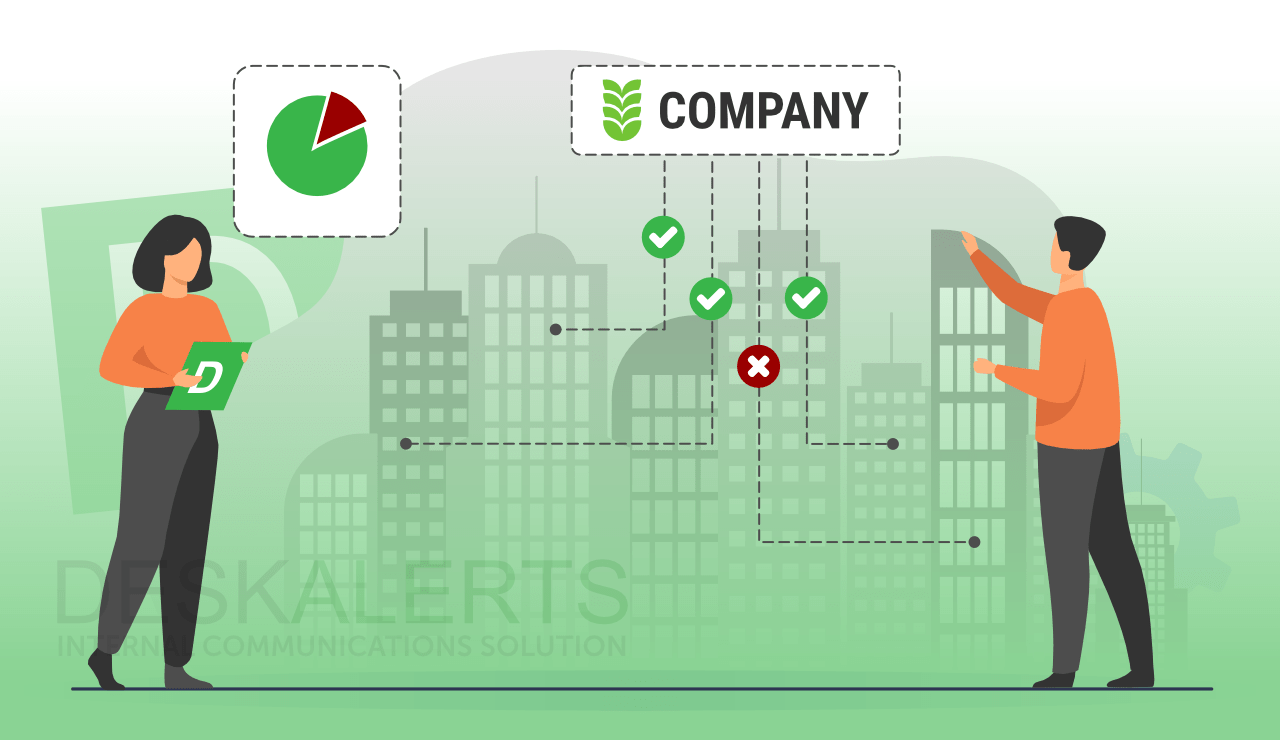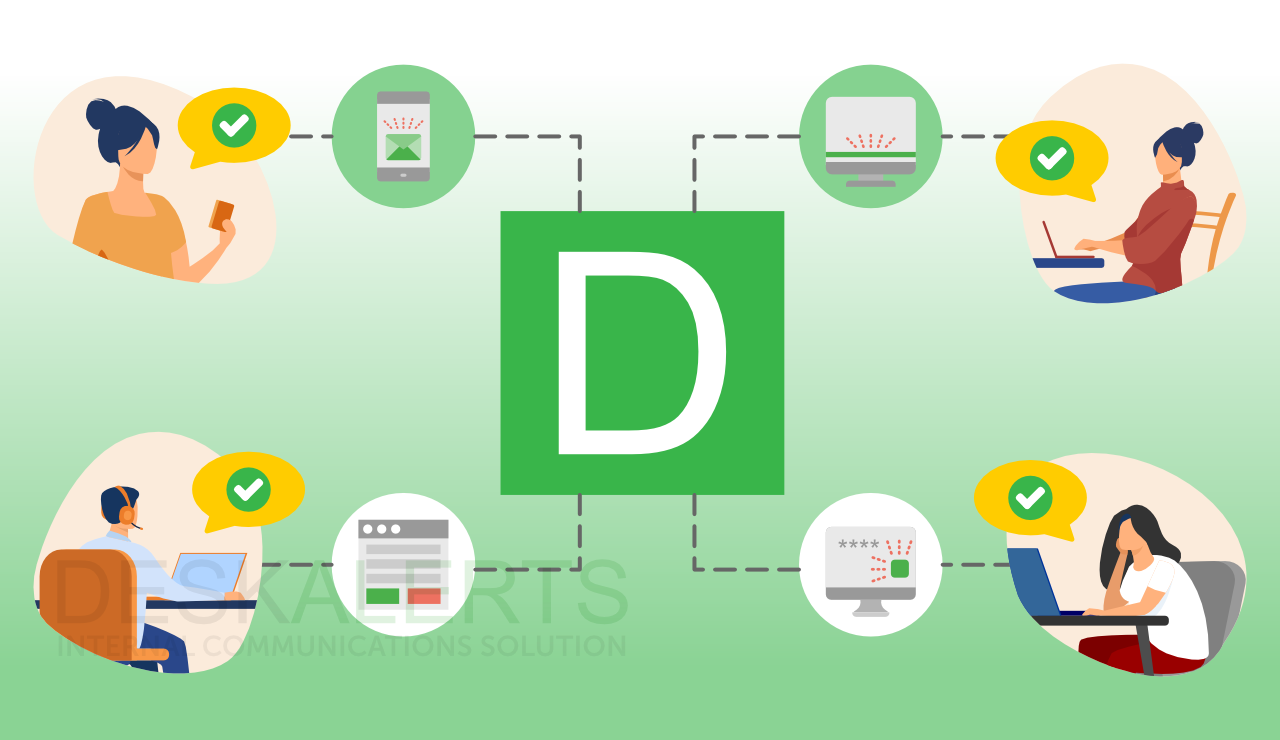
Combining all your communications into one system makes great business sense. When businesses adopt this approach they drive efficiencies, improve efficiencies and connect with unified communication solutions.
Table of contents
What are unified communications for enterprise?
What are the advantages of unified communications for enterprises?
How do you introduce unified communications to the workplace?
How DeskAlerts aligns with unified communications for enterprises?
What are unified communications for enterprise?
Unified Communications (UC) for enterprises refers to integrated systems that streamline the various communication tools and channels that are used within an organization. UC consolidates real-time and non-real-time communication services such as voice, video, messaging and collaboration tools into a unified platform. This integration simplifies and enhances communication, promoting efficiency and productivity.
UC typically includes components such as Voice over Internet Protocol (VoIP), video conferencing, instant messaging, presence technology, and collaboration tools. By combining these diverse channels, employees can seamlessly switch between different mediums and improve their ability to connect, share information and collaborate across the organization, regardless of location or device.
By allowing access to communication tools on multiple devices, promoting remote work and increasing responsiveness, UC also fosters flexibility. It can incorporate features such as file sharing, screen sharing, and unified messaging which in turn enables a more comprehensive and efficient communication experience.
Additionally, one of the benefits of unified communications is that it often integrates with other enterprise systems such as customer relationship management (CRM) or project management tools. This helps to build a more cohesive and interconnected work environment. The goal of using UC is to enhance productivity, reduce delays, and improve decision-making. Providing a more holistic and connected communication infrastructure for the entire enterprise is why unified communications is so important.
What are the advantages of unified communications for enterprises?
There are numerous advantages for businesses seeking to streamline and enhance their communication infrastructure via UC, with a wide range of benefits that significantly impact efficiency, collaboration, and overall productivity. Unified communication benefits include:
1. Seamless integration with other systems
UC integrates with various communication tools already in use within an organization’s operating environment such as voice, video, messaging, and collaboration platforms into a unified system. This integration streamlines communication processes.
2. Enhanced team collaboration
By combining diverse communication channels, UC promotes a collaborative work culture. Teams can communicate more efficiently, share files seamlessly, and conduct virtual meetings, which delivers improvements to productivity and teamwork.
3. Reduced communication costs
Another of the benefits of unified communications is that they often deliver cost savings to businesses. By centralizing communication systems, businesses can lower expenses associated with maintenance, infrastructure, and hardware for multiple systems. Additionally, the ability to conduct virtual meetings reduces travel expenses.
4. Productivity gains
By simplifying communication, UC reduces the time that your staff spend navigating between different tools or platforms. Studies show that UC solutions can increase productivity by several hours per employee per week.
5. Flexibility and mobility in the work environment
With UC, employees have the flexibility to work from anywhere, on any device. This capability not only enhances work-life balance but also increases responsiveness and productivity.
6. Improved customer service
When you integrate UC with your Customer Relationship Management (CRM) systems, it provides instant access to customer information, leading to more efficient and effective customer service.
7. Improved decision-making processes
When UC systems are integrated with data analytics tools, businesses can gain real-time insights and information necessary for quick and informed decision-making. This agility in decision-making can lead to improved business outcomes.
8. They are scalable
A major bonus of UC systems is their scalability. This feature makes it simpler for businesses to expand their communication infrastructure as the company grows. This flexibility, in turn saves costs and time in managing and upgrading communication systems.
9. Energy efficiencies
Centralizing communication infrastructure leads to reduced energy consumption. This not only helps in cost savings but also contributes to the company's sustainability efforts.
10. Ensures business continuity
UC solutions often include redundancy and failover options, ensuring business operations continue even in the face of unexpected disruptions.
How do you introduce unified communications to the workplace?
Introducing enterprise unified comms to the workplace requires a strategic approach to ensure a smooth transition and successful adoption. Here’s a step-by-step guide:
- Assess current communication systems. Evaluate the existing communication infrastructure, identify pain points, and determine how UC can address these challenges.
- Develop a strategy. Create a comprehensive plan outlining the goals, timeline, budget, and potential challenges of implementing UC. Define key stakeholders and set clear objectives for the transition.
- Educate and train employees. Organize training sessions to familiarize employees with the new UC tools. This training should cover the features, unified communications benefits, and best practices for using the integrated communication channels effectively.
- Address security and compliance. Ensure that your chosen UC system complies with any applicable security standards and regulations. Communicate the measures taken to safeguard data and privacy with your employees.
- Get buy-in from leadership. Encourage support from leadership and management. When leaders actively endorse the change, it helps motivate employees to embrace it too.
- Communicate effectively. Develop and implement a communication plan that informs employees about the upcoming changes, the reasons behind them, and the benefits the new system will bring to their work. Be transparent about the transition process.
- Make support available during the implementation. Provide assistance and support throughout the transition phase. Ensure the help desk or other support teams can address any issues or queries from employees.
- Track the progress of the implementation. Use key performance indicators (KPIs) to measure the impacts of the UC systems on productivity, communication, and any other relevant areas. Adjust the implementation plan based on the feedback received.
How DeskAlerts aligns with unified communications for enterprises
DeskAlerts is an enterprise communication solution that becomes even more powerful when integrated united communications systems for enterprises. This software solution enhances and streamlines internal communication by connecting with various elements of UC systems, which maximizes their effectiveness within the organization.
Features include:
1. Real-time notifications and alerts.
When DeskAlerts is integrated with UC systems, you can immediately distribute important alerts, updates, or emergency notifications. These messages can be delivered through various channels such as email, SMS, desktop pop-ups, or mobile apps - ensuring a rapid and widespread reach to all employees within the organization.
2. A centralized communication hub.
DeskAlerts acts as a centralized hub that complements UC systems, providing a platform for consistent, targeted, and personalized communications. This integration ensures that crucial messages are delivered promptly and efficiently across all communication channels.
3. Enhanced employee engagement
By integrating with UC, DeskAlerts promotes higher engagement and responsiveness among employees. The ability to send urgent messages through multiple channels ensures that information reaches employees promptly, encouraging a quicker response to important updates or critical situations.
4. Targeted and customizable communication.
Integrating DeskAlerts allows for tailored and segmented communication. Administrators can target specific departments or groups, ensuring that messages sent are relevant to the intended audience maximizing the impact and effectiveness of the communication.
5. Get feedback and acknowledgment
DeskAlerts enables the collection of feedback or acknowledgment from employees in real time. This helps you get a better understanding of how messages are received and acknowledged, providing insights for future improvements in communication strategies.
***
The benefits of unified communications for businesses are multifaceted, ranging from improved collaboration and productivity to significant cost savings and flexibility. Embracing UC not only revolutionizes the way businesses communicate internally but also strengthens external communication, customer service, and overall operational efficiency.
FAQ
What are the 3 main components of unified communications?
The three primary components of business unified communications are:
- Messaging - including email, chat, and instant messaging tools.
- Voice communication, encompassing voice calls, VoIP, and telephony.
- Audio and video conferencing, enabling real-time interactions and virtual meetings through audio and video channels.
What is unified communications in business?
Unified communications in business refers to the integration of various communication tools and channels into a cohesive system, streamlining voice, video, messaging, and collaboration platforms for enhanced productivity and efficiency.
What is an example of a unified communication?
An example of unified communication is a system that integrates tools like video conferencing, instant messaging, email, and voice calls allowing users to seamlessly switch between various channels for communication within a single platform or interface.
Is unified communications the future?
Unified communication represents a fundamental aspect of future communication strategies. With its ability to streamline diverse communication channels, enhance collaboration and adapt to remote work dynamics, UC is poised to remain an integral part of the future.
What is a benefit of unified communications?
A key benefit of unified communications is increased efficiency. By integrating various communication tools into a unified platform, UC streamlines processes, reduces delays, and enhances collaboration. This results in improved productivity as employees can seamlessly communicate and collaborate across different channels.
 Caroline Duncan
Caroline Duncan







